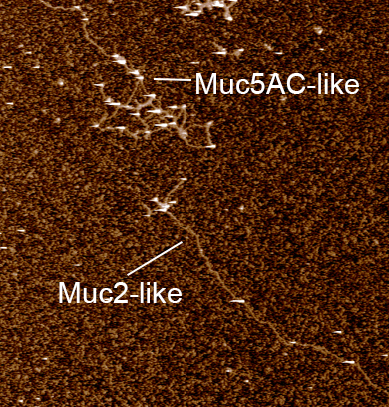Human Intestinal Mucus
Harvested from primary human transverse colon epithelia, RepliGut® Mucus reprises the complex composition and biophysical properties of native intestinal mucus for standalone studies
The Importance of the Mucus Layer for Maintaining Intestinal Health
Human intestinal mucus is an essential component of the gastrointestinal tract, playing a pivotal role in maintaining gut health and functionality. GI mucus is a polymer gel composed of a complex mixture of glycoproteins, lipids, electrolytes, and water which forms a protective barrier against harmful pathogens, mechanical damage, and noxious chemicals.
In addition to its protective function, GI mucus provides the interface between the host epithelium and microbes, which fosters a symbiotic relationship with the gut microbiota, influences immune responses, and aids in nutrient absorption. Moreover, GI mucus provides lubrication essential for smooth digestion and waste elimination.

Properties of RepliGut® Mucus
Harvested from primary human transverse colon epithelium
Mucins (including Muc2 and Muc5AC) are the most abundant proteins
Sterile derived in the absence of antibiotics
Free of bacterial protein, DNA, and metabolites
Biophysical/rheological properties similar to native human GI mucus
Human relevant glycosylation including sialic acid, succinyl and fucose groups

RepliGut® Mucus is structurally similar to native gut mucus
Atomic force microscopy image shows organization of the complex mucin polymeric network, similar to that of native GI mucus.
RepliGut® Mucus is extensively characterized
Confirmed glycosylation
Proteomics
Rheology
Microbial growth and movement
RepliGut® Mucus alters physical interactions between bacteria
Interactions of bacteria with mucus shape how they proliferate in space in multicellular colonies. Professor Sujit Datta and colleagues used RepliGut® Mucus to show how non-motile bacteria proliferate in cable-like structures in the presence of mucus, compared to random dispersion in non-polymer containing media. Read the FULL ARTICLE
Non-motile E. coli proliferating in polymer-free LB media
Non-motile E. coli proliferating in LB media supplemented with 0.5 w/v% RepliGut® Mucus
RepliGut® Mucus in Comparison
Mucus Products | Unprocessed | Gastrointestinal Origin | Free of bacterial DNA and Protein | Human Relevant |
|---|---|---|---|---|
RepliGut® Mucus | ||||
Pig Gastric Mucins | ||||
Bovine Submaxillary Mucins | ||||
Recombinant Human Mucins | ||||
Human Nasal Mucus |
Applications
Formulation compatibility
Concerned about permeability and bioavailability? Test how your formulation binds, moves or dissolves through the mucus layer
Microbial growth and phenotypes
Individually test how microbes utilize carbon from mucus or how mucus changes the growth and health of microbiome populations
Mucus degradation
Characterize mucolysis by nutritional enzymes, bacteria, or other molecules
Product Information
Order Code | Product Name | Description | Volume | Characterization |
|---|---|---|---|---|
HMUC-TC/D5 | RepliGut® Mucus – Transverse Colon | Human intestinal mucus derived from transverse colon cultures | 500uL | Viscous fluid, Greater than 1.0% solids, tested negative for bacteria |

